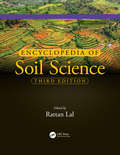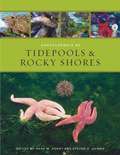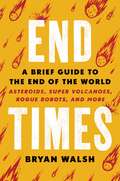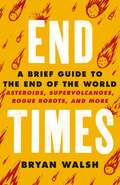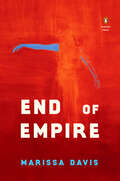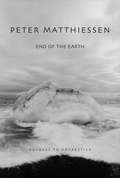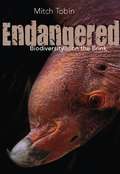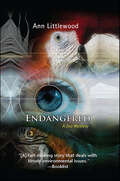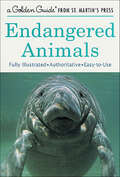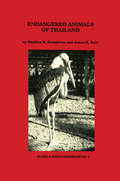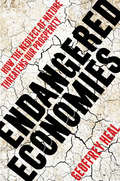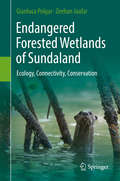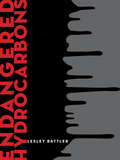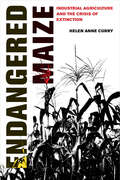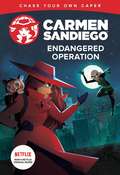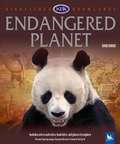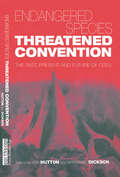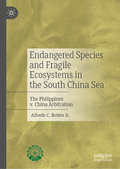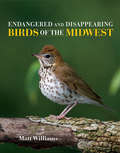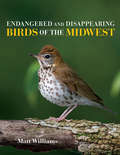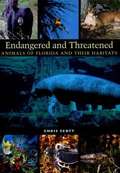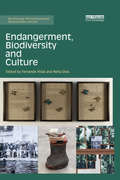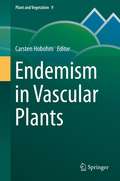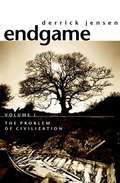- Table View
- List View
Encyclopedia of Soil Science
by Rattan LalNew and Improved Global Edition: Three-Volume Set A ready reference addressing a multitude of soil and soil management concerns, the highly anticipated and widely expanded third edition of Encyclopedia of Soil Science now spans three volumes and covers ground on a global scale. A definitive guide designed for both coursework and self-study, this latest version describes every branch of soil science and delves into trans-disciplinary issues that focus on inter-connectivity or the nexus approach. For Soil Scientists, Crop Scientists, Plant Scientists and More A host of contributors from around the world weigh in on underlying themes relevant to natural and agricultural ecosystems. Factoring in a rapidly changing climate and a vastly growing population, they sound off on topics that include soil degradation, climate change, soil carbon sequestration, food and nutritional security, hidden hunger, water quality, non-point source pollution, micronutrients, and elemental transformations. New in the Third Edition: Contains over 600 entries Offers global geographical and thematic coverage Entries peer reviewed by subject experts Addresses current issues of global significance Encyclopedia of Soil Science, Third Edition: Three Volume Set expertly explains the science of soil and describes the material in terms that are easily accessible to researchers, students, academicians, policy makers, and laymen alike. Also Available OnlineThis Taylor & Francis encyclopedia is also available through online subscription, offering a variety of extra benefits for researchers, students, and librarians, including: Citation tracking and alerts Active reference linking Saved searches and marked lists HTML and PDF format options Contact Taylor and Francis for more information or to inquire about subscription options and print/online combination packages.US: (Tel) 1.888.318.2367; (E-mail) e-reference@taylorandfrancis.comInternational: (Tel) +44 (0) 20 7017 6062; (E-mail) online.sales@tandf.co.uk
Encyclopedia of Theoretical Ecology
by Louis Gross Alan HastingsThis major reference is an overview of the current state of theoretical ecology through a series of topical entries centered on both ecological and statistical themes. Coverage ranges across scales--from the physiological, to populations, landscapes, and ecosystems. Entries provide an introduction to broad fields such as Applied Ecology, Behavioral Ecology, Computational Ecology, Ecosystem Ecology, Epidemiology and Epidemic Modeling, Population Ecology, Spatial Ecology and Statistics in Ecology. Others provide greater specificity and depth, including discussions on the Allee effect, ordinary differential equations, and ecosystem services. Descriptions of modern statistical and modeling approaches and how they contributed to advances in theoretical ecology are also included. Succinct, uncompromising, and authoritative--a "must have" for those interested in the use of theory in the ecological sciences.
Encyclopedia of Tidepools and Rocky Shores
by Steven D. Gaines Mark W. DennyThis comprehensive encyclopedia is an authoritative, one-stop reference for everyone interested in the biology and ecology of the fascinating and uniquely accessible environment. Conveniently arranged alphabetically, nearly 200 wide-ranging entries written in clear language by scientists from around the world provide a state of the art picture of tidepools and rocky shore science.
End Times: A Brief Guide to the End of the World
by Bryan WalshWhat is going to cause our extinction?How can we save ourselves and our future?End Times answers the most important questions facing humankindEnd Times is a compelling work of skilled reportage that peels back the layers of complexity around the unthinkable-and inevitable-end of humankind. From asteroids and artificial intelligence to volcanic supereruption to nuclear war, 15-year veteran science reporter and TIME editor Bryan Walsh provides a stunning panoramic view of the most catastrophic threats to the human race.In End Times, Walsh examines threats that emerge from nature and those of our own making: asteroids, supervolcanoes, nuclear war, climate change, disease pandemics, biotechnology, artificial intelligence, and extraterrestrial intelligence. Walsh details the true probability of these world-ending catastrophes, the impact on our lives were they to happen, and the best strategies for saving ourselves, all pulled from his rigorous and deeply thoughtful reporting and research.Walsh goes into the room with the men and women whose job it is to imagine the unimaginable. He includes interviews with those on the front lines of prevention, actively working to head off existential threats in biotechnology labs and government hubs. Guided by Walsh's evocative, page-turning prose, we follow scientific stars like the asteroid hunters at NASA and the disease detectives on the trail of the next killer virus.Walsh explores the danger of apocalypse in all forms. In the end, it will be the depth of our knowledge, the height of our imagination, and our sheer will to survive that will decide the future.
End Times: Asteroids, Supervolcanoes, Plagues and More
by Bryan WalshNewsweek and Bloomberg popular science and investigative journalist Bryan Walsh explores the history of extinction and offers a cutting-edge examination of existential risk, the dangerous mistakes we have yet to pay for, and concrete steps we can take to protect ourselves and future-proof our civilization.What is going to cause our extinction?How can we save ourselves and our future?End Times answers the most important questions facing humankindEnd Times is a compelling work of skilled reportage that peels back the layers of complexity around the unthinkable-and inevitable-end of humankind. From asteroids and artificial intelligence to volcanic supereruption to nuclear war, 15-year veteran science reporter and TIME editor Bryan Walsh provides a stunning panoramic view of the most catastrophic threats to the human race.In End Times, Walsh examines threats that emerge from nature and those of our own making: asteroids, supervolcanoes, nuclear war, climate change, disease pandemics, biotechnology, artificial intelligence, and extraterrestrial intelligence. Walsh details the true probability of these world-ending catastrophes, the impact on our lives were they to happen, and the best strategies for saving ourselves, all pulled from his rigorous and deeply thoughtful reporting and research.Walsh goes into the room with the men and women whose job it is to imagine the unimaginable. He includes interviews with those on the front lines of prevention, actively working to head off existential threats in biotechnology labs and government hubs. Guided by Walsh's evocative, page-turning prose, we follow scientific stars like the asteroid hunters at NASA and the disease detectives on the trail of the next killer virus.Walsh explores the danger of apocalypse in all forms. In the end, it will be the depth of our knowledge, the height of our imagination, and our sheer will to survive that will decide the future.
End of Empire (Penguin Poets)
by Marissa DavisFrom a prizewinning poet whose work &“points to an unfathomably bright future for the canon&” (Danez Smith), a stunningly lush collection about desire, resilience, and our fraught and ecstatic relationship with the natural worldA collection as remarkable for the force of its feeling as for the range of its vision, End of Empire explores the tensions of Black and American identity within an ecological framework. Inspired by the language and landscape of the poet&’s rural Kentucky hometown and the ways that inherited religious and political narratives shape our relationships with our surroundings and ourselves, these poems reckon with the ways the speaker, their body, and their natural and ideological surroundings continuously remake each other. Formally dynamic, emotionally resonant, and rich with biblical, mythological, and historical allusions, these are elegant, impeccably crafted pieces that evoke the fearsome power of nature and of the tangled, sensual self.
End of the Earth: Voyages to Antarctica
by Peter Matthiessen"Matthiessen chronicles two voyages into the frozen seas that surround a landmass larger than the continental United States, most of it buried under eternal snow and ice as much as three miles deep. Ninety percent of the world's fresh water is locked in this immense ice cap, a remote region profoundly important to our environment. The author addresses the subject with authority and passion, discussing everything from global warming and the ozone layer to the vital role of krill, the teeming crustacean that is the cornerstone of the marine food chain." "Nature lovers - birders especially - will be fascinated by descriptions of more than half of the penguin species and an astonishing array of seabirds, from tiny storm-petrels to magnificent albatrosses, which may soar for years without alighting on land; here too are close encounters with whales, leopard seals, and elephant seals, and elusive creatures such as the oceanic orca. There are also remarkable descriptions of the seldom seen polar rookeries where thousands of emperor penguins stand motionless for months at a time, brooding their giant eggs through the long, cold darkness of Antarctic winter."--BOOK JACKET.
Endangered
by Mitch TobinSince 1973, the Endangered Species Act has served as our nation's legislative ark for imperiled wildlife. But our toughest and most controversial environmental law has only recovered a handful of the more than 1,300 species under its protection. In Endangered, award-winning journalist Mitch Tobin uses firsthand accounts to show why so many species are at risk of extinction.For nearly seven years, Tobin reported from the front lines of Endangered Species Act battles. He crisscrossed the Southwest-our hottest, driest, fastest-growing region-in search of wildlife driven to the brink of extinction and solutions to the crisis. Tobin discovered that this region, with its urban sprawl, wasteful water use, and vulnerability to climate change, provides a snapshot of the issues facing species throughout the world.Yet in one of the continent's hot spots for biodiversity, Tobin also found compelling examples of collaboration. With these examples in mind, he advocates for a set of innovative policies that can preserve the species and wild places that sustain us all.Mitch Tobin worked as a journalist from 1999 to 2006, covering wildlife, wildfires, and other environmental issues for the Tucson Citizen, Arizona Daily Star, and High Country News. Endangered grew out of Tobin's yearlong series on Arizona's endangered species, which was a finalist for the John B. Oakes Award for Distinguished Environmental Journalism. His work was honored in the Best of the West competition and received first prizes from the Arizona Press Club and Arizona Associated Press Managing Editors. Today, Tobin serves as a consultant to leading conservation groups and foundations.
Endangered (Zoo Mysteries)
by Ann LittlewoodWhen a drug bust reveals exotic animals at a marijuana grow site, zookeeper Iris Oakley and a colleague ride to the rescue in the zoo's van. But instead of pets they find smuggled parrots and tortoises destined for sale to unscrupulous or unsuspecting collectors. Iris also discovers a woman who escaped the bust—dead.The murder and the drug ops are the cops' problem, but Iris is determined to break the criminal pipeline that snatches rare animals from the wild and leaves them neglected in old barns. The zoo's facilities are full, and Iris ends up with two macaws shrieking in her basement. Next, brothers from the busted family, both murder suspects, invade her home, demanding information they think their father passed on as he, too, died at the scene.Iris flees with her child, but soon realizes she must be on the offensive. People she counts on are not who they claim to be. Sorting through baffling clues and tripping over secrets old and new, Iris soon learns that everyone has an agenda. And at least one of them is deadly....
Endangered Animals (Golden Guides from St. Martin's Press)
by George S. FichterThis eBook is best viewed on a color device.Wildlife is in danger everywhere. In this timely look at the plight of endangered animals, you will find:-A survey of hundreds of animal species that are in trouble-Descriptions of the many causes of endangerment and the controversies surrounding current laws-Fascinating stories about the efforts of people to rescue species and restore harmony and balance in nature-More than a hundred dramatic full-color illustrationsHere is a valuable resource for nature lovers-for anyone, in fact, who is concerned with the fate of animals and the future of life on this planet.
Endangered Animals of Thailand
by Stephen R. HumphreyThis work presents the state of knowledge on the endangered and threatened species of Thailand. Its pragmatic purpose is to improve Thailand’s future by providing access to technical guidance for planning development projects or other land-use changes. This information also should stimulate naturalists, professional biologists, or anyone who wishes to learn about the status of animals in Thailand. Which species are now on the brink of extinction from Thailand, and why? How can the Thai people reorganize themselves to reverse the course of destruction? Can ways be found for both the people and the rest of the fauna to prosper? Another purpose is to present a case study of the effects of longterm development for human use on the biological diversity of a tropical country.
Endangered Economies: How the Neglect of Nature Threatens Our Prosperity
by Geoffrey HealIn the decades since Geoffrey Heal began his field-defining work in environmental economics, one central question has animated his research: "Can we save our environment and grow our economy?" This issue has become only more urgent in recent years with the threat of climate change, the accelerating loss of ecosystems, and the rapid industrialization of the developing world. Reflecting on a lifetime of experience not only as a leading voice in the field, but as a green entrepreneur, activist, and advisor to governments and global organizations, Heal clearly and passionately demonstrates that the only way to achieve long-term economic growth is to protect our environment. Writing both to those conversant in economics and to those encountering these ideas for the first time, Heal begins with familiar concepts, like the tragedy of the commons and unregulated pollution, to demonstrate the underlying tensions that have compromised our planet, damaging and in many cases devastating our natural world. Such destruction has dire consequences not only for us and the environment but also for businesses, which often vastly underestimate their reliance on unpriced natural benefits like pollination, the water cycle, marine and forest ecosystems, and more. After painting a stark and unsettling picture of our current quandary, Heal outlines simple solutions that have already proven effective in conserving nature and boosting economic growth. In order to ensure a prosperous future for humanity, we must understand how environment and economy interact and how they can work in harmony—lest we permanently harm both.
Endangered Forested Wetlands of Sundaland
by Gianluca Polgar Zeehan JaafarThis book informs readers on the ecology, ecosystem services, and management of Sundaland wetland ecosystems, discussing the concepts and tools necessary to conserve these imperiled habitats. Sundaland is a biogeographically defined area of South East Asia characterised by an exceptional concentration of endemic species. The unprecedented loss of wetland habitats within Sundaland warrants urgency in implementing conservation actions. The authors are both researchers who have witnessed the ongoing losses of wetland habitats in Sundaland. The first chapter introduces fundamental concepts of ecosystems, ecological processes and ecosystem services of coastal and inland wetlands. The second chapter provides an overview of the global and regional conservation status of these ecosystems. The third chapter advances the importance of wetlands management at the landscape level (drainage basins), and proposes to adopt the concept of Ecotonal Networks (ENTs) as a sustainable management method, within the theoretical framework of Resilience Theory. The fourth chapter showcases potential flagship species that can aid in raising awareness on these endangered but poorly-known ecosystems. The fifth chapter discusses sustainable ecotourism as a viable and profitable industry to manage non-urban wetland areas of Sundaland, while providing specific suggestions for future developments. The book is written for ecosystem managers, conservation scientists, ecologists, and nature enthusiasts. It consists of a coherently arranged set of scientifically accurate tools that consider societal, cultural, and economic factors to succeed in the conservation of the Sundaland wetlands, as well as other wetland habitats in the world.
Endangered Hydrocarbons
by Lesley BattlerFracking – tar-sand runoff – dirty oil extraction. This is the language of our oil-addicted 21st century society: incredibly invasive, blatant in its purpose, and richly embedded in mythological and archetypal symbolism. The ultimate goal of the industry: To core the underworld.Endangered Hydrocarbons, Lesley Battler's first full-length collection of poetry, shows that the language of hydrocarbon extraction, with its blend of sexual imagery, archetype, science, pseudoscience and the purely speculative, can be as addictive as the resource it pursues.Using pastiche and wordplay, Battler shines a floodlight on the absurdity and pervasiveness of production language in all areas of human life in the oil fields, including art, culture and politics. Incorporating texts generated by a multinational oil company, and spliced with a variety of found material (video games, home decor magazines, works by Henry James and Carl Jung), Battler deliberately tampers with her found material, treating it as crude oil—excavating, mixing, and drilling these texts to emulate extraction processes used by the industry.With traces of Dennis Lee's Testament, Larissa Lai's Automaton Biographies, and Adam Dickinson's The Polymers, this lively and refreshing take on a polarizing topic will resonate with readers of contemporary poetry who connect with environmental issues and capitalist critique.
Endangered Maize: Industrial Agriculture and the Crisis of Extinction
by Helen Anne CurryCharting the political, social, and environmental history of efforts to conserve crop diversity. Many people worry that we're losing genetic diversity in the foods we eat. Over the past century, crop varieties standardized for industrial agriculture have increasingly dominated farm fields. Concerned about what this transition means for the future of food, scientists, farmers, and eaters have sought to protect fruits, grains, and vegetables they consider endangered. They have organized high-tech genebanks and heritage seed swaps. They have combed fields for ancient landraces and sought farmers growing Indigenous varieties. Behind this widespread concern for the loss of plant diversity lies another extinction narrative that concerns the survival of farmers themselves, a story that is often obscured by urgent calls to collect and preserve. Endangered Maize draws on the rich history of corn in Mexico and the United States to uncover this hidden narrative and show how it shaped the conservation strategies adopted by scientists, states, and citizens. In Endangered Maize, historian Helen Anne Curry investigates more than a hundred years of agriculture and conservation practices to understand the tasks that farmers and researchers have considered essential to maintaining crop diversity. Through the contours of efforts to preserve diversity in one of the world's most important crops, Curry reveals how those who sought to protect native, traditional, and heritage crops forged their methods around the expectation that social, political, and economic transformations would eliminate diverse communities and cultures. In this fascinating study of how cultural narratives shape science, Curry argues for new understandings of endangerment and alternative strategies to protect and preserve crop diversity.
Endangered Operation (Carmen Sandiego Chase-Your-Own Capers)
by Houghton Mifflin HarcourtJoin Carmen Sandiego and decide where in the world to go next in this globe-trotting, daring caper! Help Carmen save wild animals of all kinds, especially the rare Amur tiger cub kidnapped from you by VILE. With 20 possible endings, your adventures can take you all over the world—or out of the game. Which will you choose?In this choose-your-own-caper story set in the world of Carmen Sandiego, you are a junior zookeeper caring for a rare newborn Amur tiger cub. VILE, in its latest plot, is stealing exotic animals to sell to a billionaire collector, and your charge is cub-napped! Carmen arrives and you decide the best way to get your cub back is to help her defeat VILE and rescue all the animals they&’ve captured. Or do you? Twenty different endings to this story keep readers coming back for more adventures with Carmen Sandiego!
Endangered Planet (Kingfisher Knowledge)
by Tony Juniper David BurnieEndangered Planet is a timely examination of the state of the earth's ecosystems. Today, humans influence every natural habitat on the planet. The consequences can be devastating--dozens of species are wiped out each year, coasts and oceans are fouled with oil spills, and grasslands and forests are destroyed to feed the appetite of modern agriculture. Endangered Planet also reveals how renewable energy, recycling, and wildlife protection will play a key role in the survival of Earth.
Endangered Species Threatened Convention: The Past, Present and Future of CITES, the Convention on International Trade in Endangered Species of Wild Fauna and Flora
by Barnabas DicksonThe Convention on International Trade in Endangered Species (CITES) is the best known and most controversial of international conservation treaties. Since it came into force 25 years ago, debate has raged over its most basic assumptions. CITES treats the international trade in wildlife as the most important threat to the continued existence of wild species. It offers a prescription of trade bans and restrictions for endangered species. However, it is now generally acknowledged that for most species habitat loss is a much more significant threat. Some argue that the CITES remedy actually exacerbates the problem by removing the incentive to conserve wildlife habitat. This collection of essays, the first of its kind, charts the controversies and changes within CITES. It provides case studies of the way CITES has dealt with particular species and notes the growing role of the South in shaping the direction of the treaty. It considers the role of sustainable use, the precautionary principle and unilateralism within CITES. Finally, it examines options for the future of CITES. Implicit within a number of the contributions is the recognition that questions of wildlife conservation cannot be divorced from wider issues of land use, development and social justice. This book provides an essential resource for policy makers, practitioners, academics and students concerned with conservation, development and trade.
Endangered Species and Fragile Ecosystems in the South China Sea: The Philippines v. China Arbitration
by Alfredo C. Robles, Jr.This book presents an in-depth analysis of the environmental issues raised in the South China Sea Arbitration Awards, which have not attracted as much attention in the Philippines as the “nine-dash line”. Specifically it focuses on the conservation of endangered species and the conservation of fragile ecosystems in the South China Sea. The aims of the book are two-fold. First, it seeks to explain the Philippine perspective on the environmental aspects of its dispute with China. The book reconstructs the Philippine perspective in part by consulting several dozens of the hundreds of documents that the Philippines submitted to the Tribunal. Some of these documents were classified as secret and would thus have never been made available to the public had it not been for the arbitration. Second, it attempts to explain the decisions of the Tribunal on jurisdiction and admissibility as well as the decisions on the merits of the dispute. The book does this by consulting not only the two Awards but also the hundreds of pages of transcripts, expert reports, supplemental submissions and written responses by the Philippines to questions posed by the Tribunal.
Endangered and Disappearing Birds of the Midwest
by Matt WilliamsFrom the birds who wake us in the morning with their cheerful chorus to those who flock to our feeders and brighten a gloomy winter day, birds fascinate us with their lively and interesting behavior and provide essential services from controlling pest populations to pollinating crops. And yet for all the benefits they provide, many species across Minnesota, Wisconsin, Illinois, Iowa, Indiana, Michigan, and Ohio are in danger of extinction due to loss of habitat, agricultural expansion, changing forest conditions, and interactions with humans. In Endangered and Disappearing Birds of the Midwest, Matt Williams profiles forty of the most beautiful and interesting birds who winter, breed, or migrate through the Midwest and whose populations are most in danger of disappearing from the region. Each profile includes the current endangered status of the species, a description of the bird's vocal and nesting patterns, and tips to help readers identify them, along with stunning color images and detailed migration maps. An exquisite and timely examination of our feathered friends, Endangered and Disappearing Birds of the Midwest is a call to action to protect these vulnerable and gorgeous creatures that enliven our world.
Endangered and Disappearing Birds of the Midwest
by Matt WilliamsThis bird-lover&’s guide to spotting the endangered birds of the Midwest features fascinating information, helpful maps, and stunning color photography.Birds captivate us with their lively behavior and colorful beauty. They also enhance our environments in many ways, from controlling pest populations to pollinating crops. Yet, sadly, many species of birds across Minnesota, Wisconsin, Illinois, Iowa, Indiana, Michigan, and Ohio are in danger of extinction due to loss of habitat, agricultural expansion, changing forest conditions, and encounters with humans.In Endangered and Disappearing Birds of the Midwest, conservationist and endangered species expert Matt Williams profiles forty of the most beautiful and fascinating birds who winter, breed, or migrate through the Midwest and whose populations are most in danger of disappearing from the region. Each profile includes the current endangered status of the species, a description of the bird's vocal and nesting patterns, and tips to help readers identify them, along with stunning color images and detailed migration maps. An exquisite and timely examination of our feathered friends, Endangered and Disappearing Birds of the Midwest is a call to action to protect these vulnerable and gorgeous creatures that enliven our world.
Endangered and Threatened Animals of Florida and Their Habitats
by Chris ScottA biological crossroads where temperate gives way to tropical and east blends into west, Florida has over twenty-five primary habitat types, several of which are unique to the state. Within these richly varied natural communities lives an astonishing abundance of animals and plants, making Florida one of the United States' most biologically diverse regions. At the same time, sadly, Florida is also one of the country's most ecologically imperiled regions, second only to California in the number of its animals and plants that have been federally designated as endangered or threatened. This fully illustrated book is a comprehensive, yet convenient and easy-to-understand guide to Florida's endangered and threatened animals and the habitats that support them. Chris Scott covers all 71 species, subspecies, or populations of mammals, birds, reptiles, fish, crustaceans, insects, corals, and mollusks. His species accounts describe each animal's listed status, identifying characteristics, historical and current distribution, biology, current threats, and conservation efforts. To make the crucial link between animals and their habitats, Scott also includes extensive discussions of Florida's natural regions; human impacts on the environment, including habitat destruction, pollution, and the introduction of invasive, nonnative species; and ongoing efforts to conserve and restore native plant and animal communities. With this wealth of information available in no other single volume, everyone who cares about the natural environment can help preserve one of America's biological treasurehouses.
Endangerment, Biodiversity and Culture (Routledge Environmental Humanities)
by Fernando Vidal and Nélia DiasThe notion of Endangerment stands at the heart of a network of concepts, values and practices dealing with objects and beings considered threatened by extinction, and with the procedures aimed at preserving them. Usually animated by a sense of urgency and citizenship, identifying endangered entities involves evaluating an impending threat and opens the way for preservation strategies. Endangerment, Biodiversity and Culture looks at some of the fundamental ways in which this process involves science, but also more than science: not only data and knowledge and institutions, but also affects and values. Focusing on an "endangerment sensibility," it encapsulates tensions between the normative and the utilitarian, the natural and the cultural. The chapters situate that specifically modern sensibility in historical perspective, and examine central aspects of its recent and present forms. This timely volume offers the most cutting-edge insights into the Environmental Humanities for researchers working in Environmental Studies, History, Anthropology, Sociology and Science and Technology Studies.
Endemism in Vascular Plants
by Carsten HobohmThe book is the first comprehensive analysis of the macroecology and geobotany of endemic vascular plants with case-studies and analyses from different regions in the world. Endemism is a pre-extinction phenomenon. Endemics are threatened with extinction. Due to international nature conservation policies and due to the perception of the public the concept's importance is increasing. Endemism can result from different biological and environmental processes. Depending on the process conservation measures should be adapted. Endemic vascular plant taxa, in the setting of their species composition and vegetation types are important features of landscapes and indicators of the quality of relating habitats. The book is an important basis for biologists, ecologists, geographers, planners and managers of nature reserves and national parks, and people generally interested in nature conservation and biogeography of vascular plants.
Endgame, Volume 1: The Problem of Civilization
by Derrick JensenEndgame, Volume 1 builds on a series of simple but increasingly provocative premises: for example, "The needs of the natural world are more important than the needs of any economic system" and "Love does not imply pacifism." A brilliant weaving together of piercing analysis and elegant prose, Endgame leads us to see that we can re-imagine our world. Derrick Jensen is the acclaimed author of A Language Older Than Words and The Culture of Make Believe, among many others. Author, teacher, activist, small farmer, and leading voice of uncompromising dissent, he regularly stirs auditoriums across the country with revolutionary spirit. Jensen holds a degree in creative writing from Eastern Washington University, a degree in mineral engineering physics from the Colorado School of Mines, and has taught at Eastern Washington University and Pelican Bay State Prison.
